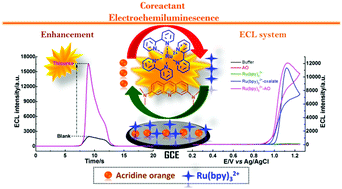Acridine orange as a coreactant for efficient electrogenerated chemiluminescence of tris(2,2′-bipyridine)ruthenium(ii) and its use in selective and sensitive detection of thiourea†
Abstract
A new and efficient anodic Ru(bpy)32+ ECL system by using acridine orange (3,6-Bis(dimethylamino)acridine, AO) as a coreactant was reported in a neutral medium. The developed Ru(bpy)32+–AO system displayed a higher ECL intensity than that of the classic Ru(bpy)32+– oxalate ECL system, and was further exploited for the ECL detection of thiourea for the first time.



 Please wait while we load your content...
Please wait while we load your content...